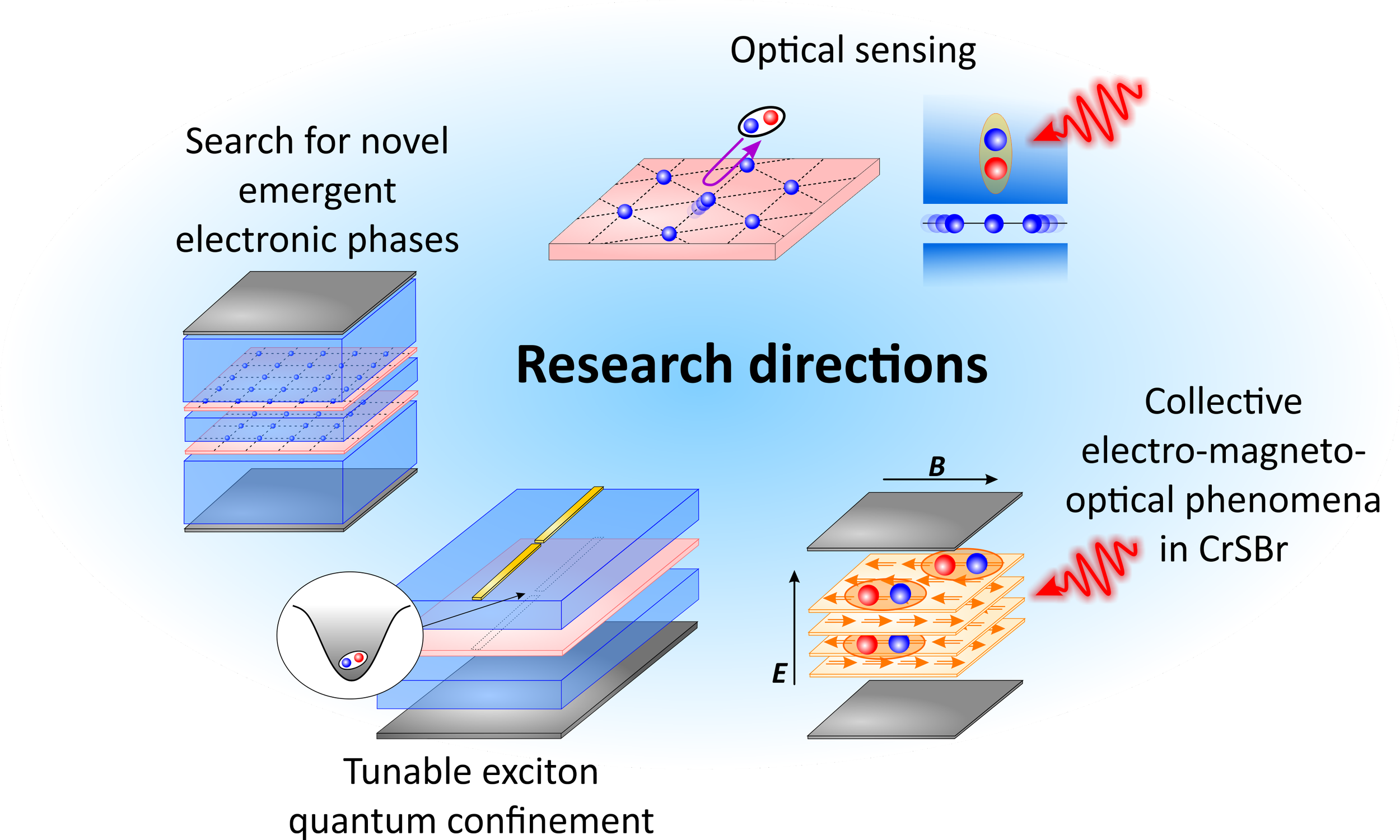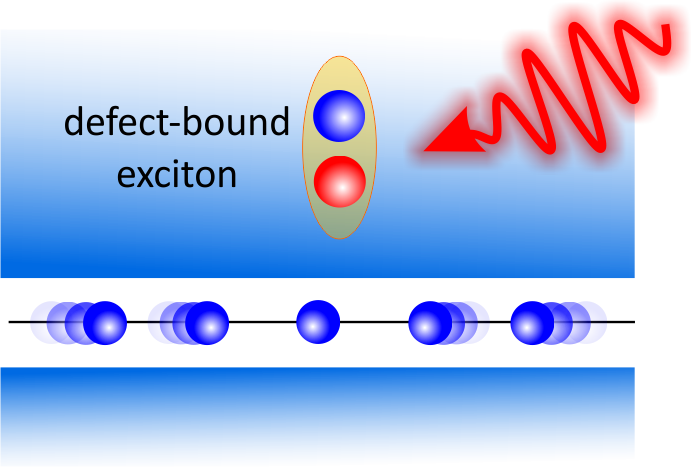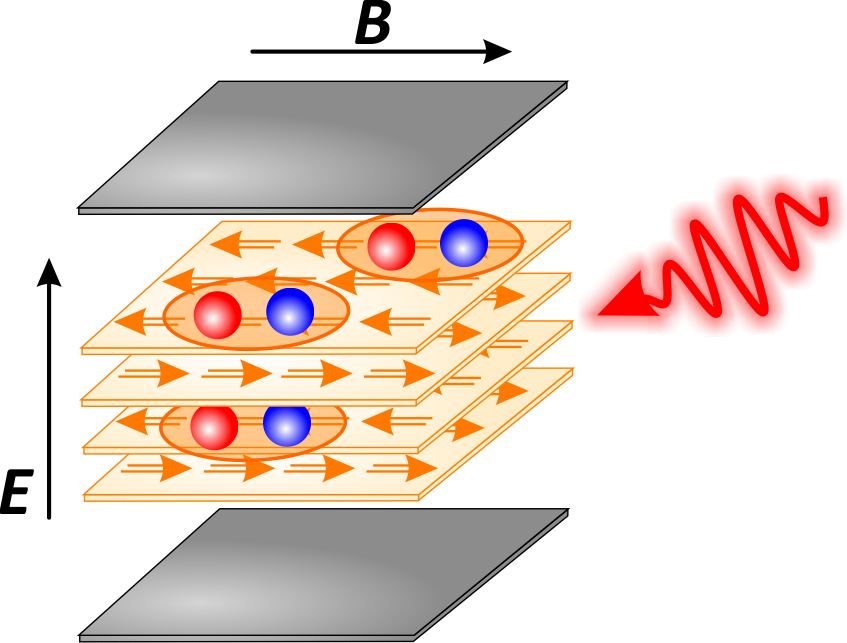Search for novel emergent quantum phases of matter
Electrically-tunable van der Waals (vdW) heterostructures featuring custom layer alignment and artificial moire superlattice potentials offer a fertile playground for realizing novel emergent phases of matter. By designing new classes of vdW structures, we are accessing and investigating elusive many-body electronic and spin states, such as electronic crystals or Nagaoka spin ferromagnets. In the future, we aim to engineer new classes of vdW devices to search for more exotic phases, including in-plane antiferromagnets, topological electron Hall crystals, quantum (pseudo-)spin liquids, and topological exciton insulators.
T. Smoleński, P. E. Dolgirev, C. Kuhlenkamp, A. Popert, Y. Shimazaki, P. Back, X. Lu, M. Kroner, K. Watanabe, T. Taniguchi, I. Esterlis, E. Demler, A. Imamoğlu, Signatures of Wigner crystal of electrons in a monolayer semiconductor, Nature 595, 53-57 (2021)
L. Ciorciaro*, T. Smoleński, I. Morera*, N. Kiper, S. Hiestand, M. Kroner, Y. Zhang, K. Watanabe, T. Taniguchi, E. Demler, A. Imamoğlu, Kinetic Magnetism in Triangular Moire Materials, Nature 623, 509-513 (2023)
Optical interfaces for sensing correlated electronic phases
Monolayers of semiconducting transition metal dichalcogenides (TMDs), such as MoSe2, display excellent optical properties with narrow, exciton optical transitions. We utilize these features to implement novel spectroscopic methods of sensing collective electronic and spin phenomena. For example, we detect long-range charge order by sensing exciton diffraction or use proximal Rydberg excitons to remotely probe the compressibility of electrons in adjacent, otherwise optically inactive layered materials (e.g., graphene).
We plan to further expand this toolbox with novel optical methods for:
Ultrafast spectroscopy of nonequilibrium electron/spin dynamics
We will employ ultrafast time-resolved experiments to investigate nonequilibrium dynamics of collective electronic phases, which constitutes one of relatively poorly explored avenues of condensed matter physics. By using short optical pulses, we will drive charge/spin system out of its equilibrium and later probe its temporal evolution in pump-probe measurements. We plan to employ this unique technique to detect quantum phase transitions between collective spin phases in twisted TMD homo-bilayers hosting topologically-nontrivial electronic bands.
Local optical sensing using charge or spin defects
Although optical spectroscopy offers great spatial resolution, in conventional experiments it is constrained by the diffraction limit of the optical spot size. In order to go beyond this fundamental obstacle, we will utilize optically-active quantum-dot-like defect centers that are hosted by various two-dimensional materials. These defects confine excitons to a nanometer-sized region and hence act as single-photon emitters with ultra-narrow emission lines. Among them, there are spinful centers (e.g., VB- in hBN) that can be coherently manipulated with microwave pulses or defects endowed with a permanent, out-of-plane electric dipole moment (e.g., quantum dots in bi- or tri-layer TMDs). By interfacing these defects with atomically-flat layers hosting strongly correlated electronic phases, we will employ defect bound excitons to locally probe quantum phase diagrams and quasiparticle excitations of the electronic system. Owing to its remarkable spatial and spectral resolution, this technique might allow us to explore uncharted territories of many-body electron physics and open new vistas for quantum computing.
Opto-mechanical detection of collective phenomena
When atomically-thin membrane is suspended over a-few-micron-sized trench in a substrate, it forms an ultra-light drumhead mechanical resonator with fundamental vibrational mode frequency of a few tens of MHz and a Q-factor reaching tens of thousands (at cryogenic temperatures). In our research, we will make use of these unique opto-mechanical systems to implement novel schemes for sensing electronic and magnetic phase transitions.
A. Popert, Y. Shimazaki, M. Kroner, K. Watanabe, T. Taniguchi, A. Imamoğlu, T. Smoleński, Optical Sensing of Fractional Quantum Hall Effect in Graphene, Nano Letters 22, 7363-7369 (2022)
T. Smoleński, K. Watanabe, T. Taniguchi, M. Kroner, A. Imamoğlu, Spin-Valley Relaxation and Exciton-Induced Depolarization Dynamics of Landau-Quantized Electrons in MoSe2 monolayer, Physical Review Letters 128, 127402 (2022)
Y. Shimazaki*, C. Kuhlenkamp*, I. Schwartz*, T. Smoleński*, K. Watanabe, T. Taniguchi, M. Kroner, R. Schmidt, M. Knap, A. Imamoğlu, Optical Signatures of Periodic Charge Distribution in a Mott-like Correlated Insulator State, Physical Review X 11, 021027 (2021)
T. Smoleński, O. Cotlet, A. Popert, P. Back, Y. Shimazaki, P. Knüppel, N. Dietler, T. Taniguchi, K. Watanabe, M. Kroner, A. Imamoglu, Interaction-Induced Shubnikov–de Haas Oscillations in Optical Conductivity of Monolayer MoSe2, Physical Review Letters 123, 097403 (2019)
T. Smoleński, M. Goryca, M. Koperski, C. Faugeras, T. Kazimierczuk, A. Bogucki, K. Nogajewski, P. Kossacki, M. Potemski, Tuning Valley Polarization in a WSe2 Monolayer with a Tiny Magnetic Field, Physical Review X 6, 021024 (2016)
Strongly coupled magnetic, optical, and electronic phenomena in layered CrSBr
The broad family of vdW materials includes a class of layered magnets featuring a permanent spin order, which can serve as building blocks of future atomically-thin spintronic devices. Among them, there is a layered CrSBr that, in contrast to majority of magnetic materials, is a semiconductor with a direct optical band gap and ultra-strong light-matter coupling. This unique material hosts anisotropic Wannier excitons that are tightly coupled to the interlayer magnetic order, which allows for controlling excitonic wave-functions with external magnetic field. In our research, we will take advantage of these extraordinary properties to engineer and assemble gate-tunable CrSBr-based devices with the aim of exploring collective magneto-opto-electronic phenomena and push opto-spintronics to new frontiers.
Tunable quantum confinement of neutral excitons
Atomically-thin materials can be nanostructured and combined together to form heterostructures with otherwise-inaccessible properties. In our research, we utilize these opportunities to design and implement electrically-tunable quantum confinement of neutral excitons that is inaccessible in conventional, epitaxial self-assembled quantum dots or quantum wires. To this end, we prepare dual-gated devices allowing us to define narrow p-i-n junctions, which restricts exciton motion to one or zero spatial dimensions. We are going to further develop this approach and apply it to different classes of layered materials in order to realize completely new tunable confinement regimes.
D. Thureja*, E. Yazici*, T. Smoleński*, D. J. Norris, M. Kroner, A. Imamoğlu, Electrically defined quantum dots for bosonic excitons, arXiv:2402.19278 (2024)
D. Thureja, A. Imamoğlu, T. Smoleński, I. Amelio, A. Popert, T. Chervy, X. Lu, S. Liu, K. Barmak, K. Watanabe, T. Taniguchi, D. J. Norris, M. Kroner, P. A. Murthy, Electrically tunable quantum confinement of neutral excitons, Nature 606, 298-304 (2022)











